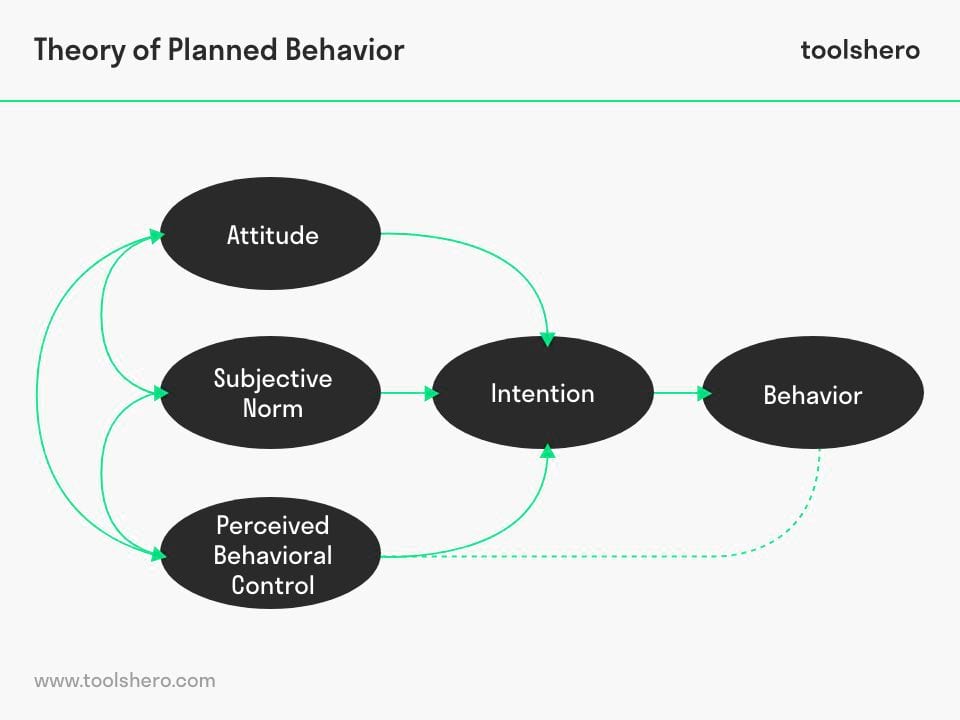Theory of Planned Behavior Model explained

Theory of Planned Behavior: This article explains the Theory of Planned Behavior, developed by Icek Ajzen in a practical way. Next to what it is (definition and background), this article also higlights Normative Beliefs and Subjective Norms, Behavioral intention and behavior and an example of this theary within health care. Als we higlight how to usw this theory to change behavior and we share the advantages and disadvantages. Enjoy reading!
What is the Theory of Planned Behavior?
Theory of Planned Behavior definition
The Theory of Planned Behavior (TPB) is a theory of psychology that links beliefs to behaviors. According to the theory, there are three core components, which together make up a person’s behavioral intentions. These three core components are:
- Attitude
- Subjective Norms
- Perceived Behavioral Control
The premise of the theory is that a person’s behavioral intention is the most important determinant of social behavior.
Origin of development of the Theory of Planned Behavior
The theory was elaborated by Icek Ajzen. His goal was to improve the Theory of Reasoned Action (TRA) that had previously been developed by Martin Fishbein in 1980 and related to various theories of learning and consistency, such as Osgood and Tannenbaum’s congruence theory, Festinger’s dissonance theory, and Heider’s balance theory.

Figure 1 – Theory of Planned Behavior (Ajzen, 1991.)
Normative Beliefs and Subjective Norms
Normative beliefs refer to an individual’s perception of social pressure, or the beliefs of relevant individuals regarding what behavior should or should not be desired.
By subjective norms is meant an individual’s perception of specific behavior that is influenced by the judgment of others such as family or friends.
Control Beliefs and Perceived Behavioral Control
Control beliefs are an individual’s beliefs about the presence of factors that may hinder or facilitate the performance of certain behaviors.
Perceived behavioral control is the ease or complexity perceived by a person to perform specific behaviors. It is believed that perceived behavioral control is determined by the total of control beliefs.
Behavioral intention and behavior
A person’s behavioral intention is the willingness to show certain behavior. Behavioral intention is an immediate antecedent of behavior based on attitudes toward the behaviors, subjective norm, and perceived behavioral control.
Behavior is the observable action of a person in a given situation. Ajzen argued that behavior is a function of intentions and perceptions of behavior control. The perceived behavioral control moderates the effect of intention on behavior.
Application theory of planned behavior in health care (example)
TPB has several applications, the most important of which are in health care and health education.
An example of this is found in anti-drug campaigns, including smoking. These campaigns often include showing statistics about people who engage in risky behavior. Its purpose is to change the subjective norm of the young.
Teens usually smoke because people in their group do too. That’s why they think smoking is the norm. But the majority of teens doesn’t smoke. Showing data on this to teens should change the subjective norm.
Psychology
The theory is widely used in health psychology. It has been shown to be useful in predicting intentions when it comes to smoking, drinking, or other drug use. One of these studies was led by Hagger and colleagues.
He noted that the three core components of this theory correspond to alcoholics’ intentions to stop or limit their drinking.
How do I use the TPB to change behavior?
With this theory as a theoretical basis, several steps can be drawn up that increase the chance of behavioral change. The team performing an intervention must specify a few things:
- Action
- Goal
- Context
- Time
For example, a goal might be to consume at least one serving of grains every day for breakfast or lunch for a month. In this example, consuming is the action, a serving of grains is the goal and the coming month is a timeline. Every day during breakfast or lunch is the context.
After that, it is necessary to identify the factors that may affect the goal. Beliefs towards certain behaviors may differ depending on a person’s social environment.
Conducting so-called provoking interviews can also be useful in applying the theory in practice. These interviews help to identify behavioral outcomes, referents, cultural factors and other factors such as barriers. Examples of types of questions that can be used during the provoking interview are:
- What do you dislike about behavior X?
- What are the disadvantages of the behavior X?
- Who is against behavior X?
- What makes it difficult to show behavior X?
- Who could be against your behavior X?
- If you want to show behavior X, can you do that?
Advantages and disadvantages of the Theory of Planned Behavior
TPB considers people’s behavior that is not found in other theories of behavior. A person’s behavioral intention alone cannot be the determinant of behavior that is beyond control. Adding the concept of perceived behavioral control to the theory, can explain the relationship between intention and actual behavior.
Social and other needs
Others criticize this behavioral theory for not considering a person’s needs before taking action. These needs would influence behavior regardless of attitudes toward behavior.
A public health example, a person may have a negative attitude and intention toward drinking alcohol, yet do so because he or she is seeking group membership.
Another criticism concerns the limitation of the Theory of Planned Behavior, in that it does not integrate emotions at play into the theory. In addition, most research on the TPB is supposed to be correlative and would benefit more from experimentation.
Dynamics between attitude, social norms and behavioral control
Some experimental studies contradict the assumption that intentions and behavior are consequences of attitudes, social norms, or behavioral control. A Sussman study (2012) prompted participants to support a specific environmental organization by signing a petition.
After the intention was formed and the petitions signed, attitudes, social norms and perceived behavioral controls changed. Participants more often indicated that they have a positive attitude towards the organization. This outcome implies that the three elements of attitudes, social norms and behavioral controls influence each other in several directions.
Now It’s Your Turn
What do you think? Do you recognize the explanation about the TPB? Do you recognize behavior as described above in yourself? Do you find it difficult to quit smoking, for example? Can you find the three core components in the behavior of people around you? Do you want to know more about this topic or do you have tips or comments?
Share your experience and knowledge in the comments box below.
More information
- Conner, M., & Armitage, C. J. (1998). Extending the theory of planned behavior: A review and avenues for further research. Journal of applied social psychology, 28(15), 1429-1464.
- Ajzen, I. (2020). The theory of planned behavior: Frequently asked questions. Human Behavior and Emerging Technologies, 2(4), 314-324.
- Ajzen, I. (1991). The theory of planned behavior. Organizational behavior and human decision processes, 50(2), 179-211.
- Gifford, R., & Sussman, R. (2012). Environmental attitudes. In S. D. Clayton (Ed.), The Oxford handbook of environmental and conservation psychology (pp. 65–80). Oxford University Press.
- Godin, G., & Kok, G. (1996). The theory of planned behavior: a review of its applications to health-related behaviors. American journal of health promotion, 11(2), 87-98.
- Rich, A., Brandes, K., Mullan, B., & Hagger, M. S. (2015). Theory of planned behavior and adherence in chronic illness: a meta-analysis. Journal of behavioral medicine, 38(4), 673-688.
How to cite this article:
Janse, B. (2022). Theory of Planned Behavior Model. Retrieved [insert date] from Toolshero: https://www.toolshero.com/psychology/theory-of-planned-behavior/
Published on: 10/01/2022 | Last update: 04/03/2023
Add a link to this page on your website:
<a href=”https://www.toolshero.com/psychology/theory-of-planned-behavior/”>Toolshero: Theory of Planned Behavior Model</a>












